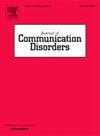Enhancing online speech and language assessment: Item development for the remote adult language experiment (ReAL-E) tool
IF 2.1
3区 医学
Q2 AUDIOLOGY & SPEECH-LANGUAGE PATHOLOGY
引用次数: 0
Abstract
Purpose: Recent technological advancements in psychology have yielded multiple unsupervised online tools for measuring cognitive skills. However, these tools do not measure key features of communication abilities in adults, such as productive speech or oral language. To address this gap, we developed the Remote Adult Language Experiment (ReAL-E) using a three-step approach that incorporates domain identification, expert evaluation, and piloting testing.
Method: Step 1 focused on domain and task identification by collaborating with experts and reviewing the literature. Step 2 included two rounds of evaluation by content and lay experts to assess the initial tool design, identify areas for refinement, and solicit feedback for desired features. Step 3 involved piloting the tool in a sample of adults recruited online.
Results: The ReAL-E tool adapted three speech planning and production tasks and four oral and written language tasks into online versions. Feedback from content and lay experts led to significant improvements, including enhanced task instructions, presentation modifications, and the incorporation of features to address potential confounds. Pilot testing demonstrated that adults perform within expected ranges, and five out of seven tasks had good to excellent preliminary reliability.
Conclusion: The development of the ReAL-E tool contributes to the field by offering a scalable, efficient method for assessing a broad range of communication skills in adults, paving the way for future research and clinical applications in developmental communication disorders. Our study underscores the collaborative effort and innovative approach required for creating a digital assessment tool that promises to expand research capabilities and improve diagnostic processes in the discipline.
加强在线语音和语言评估:远程成人语言实验(ReAL-E)工具的项目开发。
目的:最近的心理学技术进步已经产生了多种用于测量认知技能的无监督在线工具。然而,这些工具并不能衡量成年人沟通能力的关键特征,比如富有成效的演讲或口头语言。为了解决这一差距,我们开发了远程成人语言实验(ReAL-E),使用了包含领域识别、专家评估和试点测试的三步方法。方法:第一步通过与专家合作和回顾文献,专注于领域和任务识别。步骤2包括由内容专家和外行专家进行的两轮评估,以评估最初的工具设计,确定需要改进的领域,并征求对所需特性的反馈。第三步是在网上招募的成年人样本中试用该工具。结果:ReAL-E工具将3个语音规划和制作任务以及4个口头和书面语言任务改编为在线版本。来自内容专家和外行专家的反馈导致了重大的改进,包括增强的任务说明、表示修改和合并功能以解决潜在的混淆。试点测试表明,成年人的表现在预期范围内,七个任务中有五个具有良好到极好的初步可靠性。结论:ReAL-E工具的开发为该领域提供了一种可扩展的、有效的方法来评估成人的广泛沟通技能,为未来在发育性沟通障碍的研究和临床应用铺平了道路。我们的研究强调了创建数字评估工具所需的协作努力和创新方法,该工具有望扩大研究能力并改善该学科的诊断过程。
本文章由计算机程序翻译,如有差异,请以英文原文为准。
求助全文
约1分钟内获得全文
求助全文
来源期刊

Journal of Communication Disorders
AUDIOLOGY & SPEECH-LANGUAGE PATHOLOGY-REHABILITATION
CiteScore
3.30
自引率
5.90%
发文量
71
审稿时长
>12 weeks
期刊介绍:
The Journal of Communication Disorders publishes original articles on topics related to disorders of speech, language and hearing. Authors are encouraged to submit reports of experimental or descriptive investigations (research articles), review articles, tutorials or discussion papers, or letters to the editor ("short communications"). Please note that we do not accept case studies unless they conform to the principles of single-subject experimental design. Special issues are published periodically on timely and clinically relevant topics.
 求助内容:
求助内容: 应助结果提醒方式:
应助结果提醒方式:


